Synergistic ZnO–CuO/Halloysite Nanocomposite for Photocatalytic Degradation of Ciprofloxacin with High Stability and Reusability
Abstract
1. Introduction
2. Materials and Methods
2.1. Materials
2.2. Synthesis
2.3. Characterizations
2.4. Photocatalytic, Scavengers, and Recyclability Tests
3. Results
3.1. Structural Analysis of Natural and Doping Zn0.5Cu0.5O Nanopowder of Halloysite
3.2. Morphological Investigation
3.3. Optical Properties
4. Photocatalytic Experiments
4.1. Degradation Reaction Mechanism
4.2. Exploring Nanocomposite Reusability
5. Conclusions
Author Contributions
Funding
Data Availability Statement
Acknowledgments
Conflicts of Interest
References
- Papoulis, D. Halloysite based nanocomposites and photocatalysis: A Review. Appl. Clay Sci. 2019, 168, 164–174. [Google Scholar] [CrossRef]
- Drits, V.A.; Sakharov, B.A.; Hillier, S. Phase and structural features of tubular halloysite (7 Å). Clay Miner. 2018, 53, 691–720. [Google Scholar] [CrossRef]
- Gianni, E.; Pospíšil, M.; Scholtzová, E. Halloysite as a carrier/sorbent of diclofenac: A molecular simulations study. Surf. Interfaces 2025, 70, 106710. [Google Scholar] [CrossRef]
- Fahimizadeh, M.; Wong, L.W.; Baifa, Z.; Sadjadi, S.; Auckloo, S.A.B.; Palaniandy, K.; Pasbakhsh, P.; Tan, J.B.L.; Singh, R.K.R.; Yuan, P. Halloysite clay nanotubes: Innovative applications by smart systems. Appl. Clay Sci. 2024, 251, 107319. [Google Scholar] [CrossRef]
- Filice, S.; Bongiorno, C.; Libertino, S.; Compagnini, G.; Gradon, L.; Iannazzo, D.; La Magna, A.; Scalese, S. Structural characterization and adsorption properties of dunino raw halloysite mineral for dye removal from water. Materials 2021, 14, 3676. [Google Scholar] [CrossRef]
- Filice, S.; Bongiorno, C.; Libertino, S.; Gradon, L.; Iannazzo, D.; Scalese, S. Photo-Fenton Degradation of Methyl Orange with Dunino Halloysite as a Source of Iron. Catalysts 2022, 12, 257. [Google Scholar] [CrossRef]
- Danyliuk, N.; Tomaszewska, J.; Tatarchuk, T. Halloysite nanotubes and halloysite-based composites for environmental and biomedical applications. J. Mol. Liq. 2020, 309, 113077. [Google Scholar] [CrossRef]
- Zsirka, B.; Vágvölgyi, V.; Horváth, E.; Juzsakova, T.; Fónagy, O.; Szabó-bárdos, E.; Kristóf, J. Halloysite-Zinc Oxide Nanocomposites as Potential Photocatalysts. Minerals 2022, 12, 476. [Google Scholar] [CrossRef]
- Yu, H.; Xu, H.; Hao, T.; Yuan, Y.; Zhang, B.; Wang, H.; Shao, G.; Fan, B.; Lu, H. Facile synthesis of ZnO/halloysite nanotube composite with greatly enhanced photocatalytic performance. Colloids Surf. A Physicochem. Eng. Asp. 2024, 688, 133633. [Google Scholar] [CrossRef]
- Aghababaei, N.; Abdouss, M.; Hosseini-Monfared, H.; Ghanbari, F. Photocatalytic degradation of diclofenac using a novel double Z-scheme catalyst (O-g-C3N4/ZnO/TiO2@halloysite nanotubes): Degradation mechanism, identification of by-products and environmental implementation. J. Water Process Eng. 2023, 53, 103702. [Google Scholar] [CrossRef]
- Albuquerque, W.; Trigueiro, P.; Silva, B.V.; Neves, L.; Almeida, L.C.; Peña-Garcia, R.R. A novel RuO2@ZnO-Alginate-Halloysite composite for the effective degradation of Eosin Yellow dye and Ciprofloxacin drug. Mater. Res. Bull. 2024, 182, 113178. [Google Scholar] [CrossRef]
- Pouthika, K.; Madhumitha, G. Tailoring interfacial charge separation in Z-Scheme CuO@TiO2@halloysite heterostructure for efficient photocatalytic removal of Congo red. J. Taiwan Inst. Chem. Eng. 2024, 166, 105752. [Google Scholar] [CrossRef]
- Chen, S.; Zhang, L.; Alshammari, D.A.; Hessien, M.M.; Yu, W.; Cui, L.; Ren, J.; El-Bahy, Z.M.; Guo, Z. Z-scheme Ag2O/ZnO heterostructure on carbon fibers for efficient photocatalysis of tetracycline. Sep. Purif. Technol. 2025, 354, 129414. [Google Scholar] [CrossRef]
- Shoran, S.; Dahiya, S.; Rani, M.; Nehra, S.; Sharma, A.; Chaudhary, S. Synergistic photocatalysis of VO2-A/g-C3N4 composites for efficient degradation of anionic and cationic dyes: Towards a sustainable environmental solution. Appl. Surf. Sci. 2025, 684, 161852. [Google Scholar] [CrossRef]
- Xue, Q.; Lin, H.; Feng, Q.; Yang, Y.; Dong, M.; Hu, K.; Song, B.; Goh, P.S.; Shen, X. Synergistic photocatalysis and fenton-like process driven by a biochar-supported biochar/iron hydroxide oxide/bismuth molybdate S-type heterojunction for tetracycline degradation: Mechanistic insights and degradation pathways. Appl. Surf. Sci. 2025, 679, 161277. [Google Scholar] [CrossRef]
- Dalhatou, S.; Sali, M.; Tetteh, S.; Boubakari, A.; Talami, B.; Zeghioud, H.; Kane, A.; El Jery, A.; Assadi, A.A.; Obada, D.O. Sorbent and Photocatalytic Potentials of Local Clays for the Removal of Organic Xenobiotic: Case of Crystal Violet. Catalysts 2022, 12, 899. [Google Scholar] [CrossRef]
- Kowalczyk, A.; Rutkowska, M.; Gnyla, S.; Pacia, M.; Chmielarz, L. Synergistic Effect of Co and Ni Co-Existence on Catalytic Decomposition of Ammonia to Hydrogen—Effect of Catalytic Support and Mg-Al Oxide Matrix. ChemEngineering 2024, 8, 55. [Google Scholar] [CrossRef]
- Mylarappa, M.; Raghavendra, N.; Bhumika, N.R.; Chaithra, C.H.; Nagalaxmi, B.N.; Kumara, K.N.S. Study of ZnO nanoparticle-supported clay minerals for electrochemical sensors, photocatalysis, and antioxidant applications. ChemPhysMater 2024, 3, 83–93. [Google Scholar] [CrossRef]
- de Moraes, N.P.; Pereira, R.A.; da Silva, T.V.C.; da Silva, B.H.B.; de Assis, G.P.; Campos, T.M.B.; Thim, G.P.; de Vasconcelos Lanza, M.R.; de Freitas, L.; Rodrigues, L.A. Cross-linked cellulose beads as an eco-friendly support for ZnO/SnO2/carbon xerogel hybrid photocatalyst: Exploring the synergy between adsorption and photocatalysis under simulated sunlight. Int. J. Biol. Macromol. 2024, 254, 127826. [Google Scholar] [CrossRef]
- Nadeem, M.S.; Munawar, T.; Mukhtar, F.; Rabbani, A.W.; Rehman, N.U.; Mahmood, K.; Iqbal, F. Facile synthesis of PANI and rGO supported Y/Pr co-doped ZnO: Boosted solar light-driven photocatalysis. Appl. Phys. A Mater. Sci. Process. 2023, 129, 450. [Google Scholar] [CrossRef]
- Trigueiro, P.; Albuquerque, W.A.; Jerônimo, A.G.; Rodrigues, M.S.; França, E.L.T.; Peña-Garcia, R.R. CuO-TiO2–Saponite Ternary Nanocomposite for Efficient Removal of Bromocresol Green Dye. Minerals 2024, 14, 1268. [Google Scholar] [CrossRef]
- Lv, H.; Wang, P.; Lv, Y.; Dong, L.; Li, L.; Xu, M.; Fu, L.; Yue, B.; Yu, D. Piezo-Photocatalytic Degradation of Ciprofloxacin Based on Flexible BiVO4 PVDF Nanofibers Membrane. Catalysts 2025, 15, 163. [Google Scholar] [CrossRef]
- Monroy, L.H.; Tavares, J.R.; Dumont, M.-J. Photodegradation of ciprofloxacin using an alginate/TiO2 hydrogel for water remediation. J. Environ. Chem. Eng. 2025, 13, 115868. [Google Scholar] [CrossRef]
- Pham, X.N.; Nguyen, M.B.; Doan, H.V. Direct synthesis of highly ordered Ti-containing Al-SBA-15 mesostructured catalysts from natural halloysite and its photocatalytic activity for oxidative desulfurization of dibenzothiophene. Adv. Powder Technol. 2020, 31, 3351–3360. [Google Scholar] [CrossRef]
- Bayliss, P. Unit-Cell Dimensions of Two-Dimensionai Clay Minerals. Powder Diffr. 1989, 4, 19–20. [Google Scholar] [CrossRef]
- Siranidi, E.; Hillier, S.; Chryssikos, G.D. Structure of tubular halloysite-(10 Å) and its transition to halloysite-(7 Å) by infrared spectroscopy and X-ray diffraction. Clays Clay Miner. 2024, 72, e33. [Google Scholar] [CrossRef]
- Talami, B.; Zeghioud, H.; Dalhatou, S.; Bonnet, P.; Caperaa, C.; Ligny, R.; Assadi, A.A.; Massai, H.; Kane, A. A New Sunlight Active Photocatalyst Based on CuO-TiO2-Clay Composite for Wastewater Remediation: Mechanistic Insights and Degradation Optimization. Water Air Soil Pollut. 2024, 235, 104. [Google Scholar] [CrossRef]
- Ouyang, J.; Mu, D.; Zhang, Y.; Yang, H. Mineralogy and Physico-Chemical Data of Two Newly Discovered Halloysite in China and Their Contrasts with Some Typical Minerals. Minerals 2018, 8, 108. [Google Scholar] [CrossRef]
- Frost, R.L.; Kristof, J.; Horvath, E.; Kloprogge, J.T. Rehydration and Phase Changes of Potassium Acetate-Intercalated Halloysite at 298 K. J. Colloid Interface Sci. 2000, 226, 318–327. [Google Scholar] [CrossRef]
- Frost, R.L.; Xi, Y.; He, H. Synthesis, characterization of palygorskite supported zero-valent iron and its application for methylene blue adsorption. J. Colloid Interface Sci. 2010, 341, 153–161. [Google Scholar] [CrossRef]
- Kloprogge, J.T.; Frost, R.L. Raman microprobe spectroscopy of hydrated halloysite from a Neogene cryptokarst from Southern Belgium. J. Raman Spectrosc. 1999, 30, 1079–1085. [Google Scholar] [CrossRef]
- Frost, R.L.; Shurvell, H.F. Raman Microprobe Spectroscopy of Halloysite. Clays Clay Miner. 1997, 45, 68–72. [Google Scholar] [CrossRef]
- Le Ba, T.; Alkurdi, A.Q.; Lukács, I.E.; Molnár, J.; Wongwises, S.; Gróf, G.; Szilágyi, I.M. A novel experimental study on the rheological properties and thermal conductivity of halloysite nanofluids. Nanomaterials 2020, 10, 1834. [Google Scholar] [CrossRef] [PubMed]
- Frost, R.L.; Kristof, J. Intercalation of Halloysite: A Raman Spectroscopic Study. Clays Clay Miner. 1997, 45, 551–563. [Google Scholar] [CrossRef]
- Loh, E. Optical vibrations in sheet silicates. J. Phys. C Solid State Phys. 1973, 6, 1091–1104. [Google Scholar] [CrossRef]
- Liu, X.; Duan, Y.; Yang, X.; Huang, L.; Gao, M.; Wang, T. Enhancement of magnetic properties in FeCoNiCr0.4CuX high entropy alloys through the cocktail effect for megahertz electromagnetic wave absorption. J. Alloys Compd. 2021, 872, 159602. [Google Scholar] [CrossRef]
- Joussein, E.; Petit, S.; Churchman, J.; Theng, B.; Righi, D.; Delvaux, B. Halloysite clay minerals—A review. Clay Miner. 2005, 40, 383–426. [Google Scholar] [CrossRef]
- López, R.; Villa-Sánchez, G.; de la Cruz, I.V.; Encarnación-Gómez, C.; Castrejón-Sánchez, V.H.; Coyopol, A.; Mastache, J.E.; Leyva-Porras, C. Cupric oxide (CuO)/zinc oxide (ZnO) heterojunction diode with low turn-on voltage. Results Phys. 2021, 22, 103891. [Google Scholar] [CrossRef]
- Soares, A.S.; Araujo, F.P.; França, R.; Osajima, J.A.; Guerra, Y.; Castro-Lopes, S.; Silva-Filho, E.C.; Santos, F.E.; Almeida, L.C.; Viana, B.C.; et al. Effect of pH on the growth and ibuprofen photocatalytic response of Zn1−xCoxO compound synthesized by the co-precipitation method. J. Mater. Res. 2023, 38, 2439–2452. [Google Scholar] [CrossRef]
- Kloprogge, J.T.; Frost, R.L. Infrared emission spectroscopy of Al-pillared beidellite. Appl. Clay Sci. 1999, 15, 431–445. [Google Scholar] [CrossRef]
- Decremps, F.; Pellicer-Porres, J.; Saitta, A.M.; Chervin, J.-C.; Polian, A. High-pressure Raman spectroscopy study of wurtzite ZnO. Phys. Rev. B Condens. Matter Mater. Phys. 1998, 65, 92101. [Google Scholar] [CrossRef]
- Wang, W.; Zhou, Q.; Fei, X.; He, Y.; Zhang, P.; Zhang, G.; Peng, L.; Xie, W. Synthesis of CuO nano- and micro-structures and their Raman spectroscopic studies. CrystEngComm 2010, 12, 2232. [Google Scholar] [CrossRef]
- Silva, M.; Trigueiro, P.; Jerônimo, A.; Barbosa, R.; Lins, A.; Albuquerque, W.; Araujo, F.P.; Osajima, J.A.; Peña-Garcia, R.R. Eco-friendly synthesis of Zn0.97La0.03O compound with natural polysaccharide and its application in methylene blue and eosin dyes discoloration. Mater. Lett. 2024, 363, 136256. [Google Scholar] [CrossRef]
- Kuriakose, S.; Satpati, B.; Mohapatra, S. Highly efficient photocatalytic degradation of organic dyes by Cu doped ZnO nanostructures. Phys. Chem. Chem. Phys. 2015, 17, 25172–25181. [Google Scholar] [CrossRef]
- Castro-Lopes, S.; Guerra, Y.; Silva-Sousa, A.; Oliveira, D.M.; Gonçalves, L.A.P.; Franco, A.; Padrón-Hernández, E.; Peña-Garcia, R. Influence of pH on the structural and magnetic properties of Fe-doped ZnO nanoparticles synthesized by sol gel method. Solid State Sci. 2020, 109, 106438. [Google Scholar] [CrossRef]
- França, R.; Araujo, F.P.; Neves, L.; Melo, A.; Lins, A.; Soares, A.S.; Osajima, J.A.; Guerra, Y.; Almeida, L.C. Photoresponsive Activity of the Zn0.94Er0.02Cr0.04O Compound with Hemisphere-like Structure Obtained by Co-Precipitation. Materials 2023, 16, 1446. [Google Scholar] [CrossRef]
- Pouthika, K.; Madhumitha, G. Synergistic synthesis of Carrisa edulis fruit extract capped heterogeneous CuO-ZnO-HNT composite for photocatalytic removal of organic pollutants. Inorganica Chim. Acta 2023, 551, 121457. [Google Scholar] [CrossRef]
- Geng, S.; Chen, D.; Guo, Z.; Li, Q.; Wen, M.; Wang, J.; Guo, K.; Wang, J.; Wang, Y.; Yu, L.; et al. Halloysite-Nanotube-Mediated High-Flux γ-Al2O3 Ultrafiltration Membranes for Semiconductor Wastewater Treatment. Membranes 2025, 15, 130. [Google Scholar] [CrossRef]
- Wang, J.; Liu, Y.; Tang, X.; Sun, Y.; Li, F. Photocatalytic decomposition of toxic phosphine gas over halloysite nanotubes co-doped by Ni and Fe3O4 and theory calculation of its mechanism. Chem. Eng. J. 2025, 506, 159994. [Google Scholar] [CrossRef]
- Lins, A.; Jerônimo, A.G.; Barbosa, R.; Neves, L.; Trigueiro, P.; Almeida, L.C.; Osajima, J.A.; Pereira, F.A.; Peña-Garcia, R.R. Facile Synthesis of Ni-Doped ZnO Nanoparticles Using Cashew Gum: Investigation of the Structural, Optical, and Photocatalytic Properties. Molecules 2023, 28, 7772. [Google Scholar] [CrossRef] [PubMed]
- Martins, E.; Jerônimo, A.G.; Barbosa, R.; Neves, L.; Santos, E.; Meira, T.; Osajima, J.A.; Trigueiro, P.; Soares, A.S.; Peña-Garcia, R.R. Influence of Al cations insertion on the structural, morphological, optical properties, and methyl orange photocatalytic remotion of Pr-doped ZnO system. Mater. Chem. Phys. 2024, 318, 129300. [Google Scholar] [CrossRef]
- Jerônimo, A.G.; Barbosa, R.; Neves, L.; Trigueiro, P.; Guerra, Y.; Santos, E.; Almeida, L.C.; Osajima, J.A.; Araujo, F.P.; Peña-Garcia, R.R. Simultaneous La3+ and Cu2+ cations insertion in the ZnO crystal structure and its effect on the structural, optical, and photocatalytic properties. J. Mater. Sci. 2024, 59, 1280–1297. [Google Scholar] [CrossRef]
- França, R.; Araujo, F.P.; Castro-Lopes, S.; Neves, L.; Melo, A.; Jerônimo, A.G.; Osajima, J.A.; Guerra, Y.; Almeida, L.C.; Peña-Garcia, R. Effect of Cr cations addition on the structural, morphological, optical, and photocatalytic properties of Er-doped ZnO structures. Mater. Today Commun. 2023, 37, 107419. [Google Scholar] [CrossRef]
- Alsulmi, A.; Mohammed, N.N.; Soltan, A.; Messih, M.F.A.; Ahmed, M.A. Engineering S-scheme CuO/ZnO heterojunctions sonochemically for eradicating RhB dye from wastewater under solar radiation. RSC Adv. 2023, 13, 13269–13281. [Google Scholar] [CrossRef]
- Peng, H.; Liu, X.; Tang, W.; Ma, R. Facile synthesis and characterization of ZnO nanoparticles grown on halloysite nanotubes for enhanced photocatalytic properties. Sci. Rep. 2017, 7, 2250. [Google Scholar] [CrossRef]
- Suppaso, C.; Pongkan, N.; Intachai, S.; Rattanawongsa, W.; Baoulan, A.; Yamauchi, Y.; Asakura, Y.; Khaorapapong, N. Enhancement of photocatalytic efficiency of copper oxide/zinc oxide-montmorillonite photocatalyst under visible light irradiation. Sci. Technol. Adv. Mater. 2025, 26, 2469484. [Google Scholar] [CrossRef]
- Nagpal, K.; Rauwel, E.; Estephan, E.; Soares, M.R.; Rauwel, P. Significance of Hydroxyl Groups on the Optical Properties of ZnO Nanoparticles Combined with CNT and PEDOT:PSS. Nanomaterials 2022, 12, 3546. [Google Scholar] [CrossRef] [PubMed]
- Khoddam, M.A.; Norouzbeigi, R.; Velayi, E.; Cavallaro, G. Statistical-based optimization and mechanism assessments of Arsenic (III) adsorption by ZnO-Halloysite nanocomposite. Sci. Rep. 2024, 14, 21629. [Google Scholar] [CrossRef] [PubMed]
- Shaikh, H.; Saleem, R.; Halepoto, I.A.; Barhaam, M.S.; Soomro, M.Y.; Abbasi, M.A.; Shaikh, N.M.; Bhatti, M.A.; Wassan, S.H.; Dawi, E.; et al. Facile and Low-Cost Fabrication of ZnO/Kaolinite Composites by Modifying the Kaolinite Composition for Efficient Degradation of Methylene Blue Under Sunlight Illumination. Catalysts 2025, 15, 566. [Google Scholar] [CrossRef]
- Trigueiro, P.; Jerônimo, A.G.; Albuquerque, W.A.; da Silva, W.L.; Osajima, J.A.; Jaber, M.; Peña-Garcia, R.R. Shaping a ZnO-alginate-hectorite nanocomposite for improved photocatalytic drug removal. Appl. Mater. Today 2025, 44, 102680. [Google Scholar] [CrossRef]
- Jiang, Q.; Han, Z.; Qu, N.; Sun, L.; Yuan, Y.; Ren, Y.; Cheng, Z. Low-cost magnetic clay derivants from palygorskite/MIL-101(Fe) for high-performance adsorption-photocatalysis. Appl. Clay Sci. 2022, 218, 106427. [Google Scholar] [CrossRef]
- Damaceno, D.H.; Trigueiro, P.; Lima, L.C.B.; Honorio, L.M.; Peña-Garcia, R.; Furtini, M.B.; Guerra, Y.; Fonseca, M.G.; da Silva-Filho, E.C.; Jaber, M.; et al. ZnO-Saponite Nanocomposite: Input of Adsorption and Photocatalysis for Removal of Rhodamine B Dye. Water Air Soil Pollut. 2024, 235, 656. [Google Scholar] [CrossRef]
- Sacco, O.; Vaiano, V.; Matarangolo, M. ZnO supported on zeolite pellets as efficient catalytic system for the removal of caffeine by adsorption and photocatalysis. Sep. Purif. Technol. 2018, 193, 303–310. [Google Scholar] [CrossRef]
- Qi, Y.; Zhao, S.; Shen, Y.; Jiang, X.; Lv, H.; Han, C.; Liu, W.; Zhao, Q. A Critical Review of Clay Mineral-Based Photocatalysts for Wastewater Treatment. Catalysts 2024, 14, 575. [Google Scholar] [CrossRef]
- Li, X.; Simon, U.; Bekheet, M.F.; Gurlo, A. Mineral-Supported Photocatalysts: A Review of Materials, Mechanisms and Environmental Applications. Energies 2022, 15, 5607. [Google Scholar] [CrossRef]
- Freitas, W.; Trigueiro, P.; Marinho, T.; Honorio, L.M.; Silva-Filho, E.C.; Furtini, M.B.; Cecília, J.A.; Fonseca, M.G.; Osajima, J. The Role of Clay Mineral-Derived Photocatalysts in Insights of Remediation. Ceramics 2022, 5, 862–882. [Google Scholar] [CrossRef]
- Van Thuan, D.; Nguyen, T.B.H.; Pham, T.H.; Kim, J.; Chu, T.T.H.; Nguyen, M.V.; Nguyen, K.D.; Al-onazi, W.A.; Elshikh, M.S. Photodegradation of ciprofloxacin antibiotic in water by using ZnO-doped g-C3N4 photocatalyst. Chemosphere 2022, 308, 136408. [Google Scholar] [CrossRef] [PubMed]
- Hassaan, M.A.; Meky, A.I.; Fetouh, H.A.; Ismail, A.M.; El Nemr, A. Central composite design and mechanism of antibiotic ciprofloxacin photodegradation under visible light by green hydrothermal synthesized cobalt-doped zinc oxide nanoparticles. Sci. Rep. 2024, 14, 9144. [Google Scholar] [CrossRef]
- Freitas, W.A.; Soares, B.E.C.F.; Rodrigues, M.S.; Trigueiro, P.; Honorio, L.M.C.; Peña-Garcia, R.; Alcântara, A.C.S.; Silva-Filho, E.C.; Fonseca, M.G.; Furtini, M.B.; et al. Facile synthesis of ZnO-clay minerals composites using an ultrasonic approach for photocatalytic performance. J. Photochem. Photobiol. A Chem. 2022, 429, 113934. [Google Scholar] [CrossRef]
- Meng, L.; Zhao, C.; Wang, T.; Chu, H.; Wang, C.-C. Efficient ciprofloxacin removal over Z-scheme ZIF-67/V-BiOIO3 heterojunctions: Insight into synergistic effect between adsorption and photocatalysis. Sep. Purif. Technol. 2023, 313, 123511. [Google Scholar] [CrossRef]
- Jayeola, K.D.; Sipuka, D.S.; Sebokolodi, T.I.; Nkwachukwu, O.V.; Muzenda, C.; Koiki, B.A.; Babalola, J.O.; Zhou, M.; Arotiba, O.A. The design and characterisation of a Z-scheme Bi2O2S/ZnO heterojunction photoanode for the photoelectrochemical removal of ciprofloxacin in synthetic and real wastewater. Chem. Eng. J. 2024, 479, 147482. [Google Scholar] [CrossRef]
- Sarkhosh, M.; Sadani, M.; Abtahi, M.; Mohseni, S.M.; Sheikhmohammadi, A.; Azarpira, H.; Najafpoor, A.A.; Atafar, Z.; Rezaei, S.; Alli, R.; et al. Enhancing photo-degradation of ciprofloxacin using simultaneous usage of eaq− and OH over UV/ZnO/I− process: Efficiency, kinetics, pathways, and mechanisms. J. Hazard. Mater. 2019, 377, 418–426. [Google Scholar] [CrossRef]
- Wen, X.-J.; Niu, C.-G.; Zhang, L.; Liang, C.; Guo, H.; Zeng, G.-M. Photocatalytic degradation of ciprofloxacin by a novel Z-scheme CeO2–Ag/AgBr photocatalyst: Influencing factors, possible degradation pathways, and mechanism insight. J. Catal. 2018, 358, 141–154. [Google Scholar] [CrossRef]
- Ahamad, T.; Naushad, M.; Alshehri, S.M. Analysis of degradation pathways and intermediates products for ciprofloxacin using a highly porous photocatalyst. Chem. Eng. J. 2021, 417, 127969. [Google Scholar] [CrossRef]
- Ngo, H.S.; Nguyen, T.L.; Tran, N.T.; Le, H.C. Experimental Study on Kinetics and Mechanism of Ciprofloxacin Degradation in Aqueous Phase Using Ag-TiO2/rGO/Halloysite Photocatalyst. Catalysts 2023, 13, 225. [Google Scholar] [CrossRef]
- Hassani, A.; Khataee, A.; Karaca, S.; Karaca, C.; Gholami, P. Sonocatalytic degradation of ciprofloxacin using synthesized TiO2 nanoparticles on montmorillonite. Ultrason. Sonochem. 2017, 35, 251–262. [Google Scholar] [CrossRef]
- Nasiri, H.; Golmohammadi, M.; Sazegaran, H. Photocatalysts Capability of Bentonite-ZnO Nanocomposite Synthesized by Solution Combustion in Ciprofloxacin Degradation. J. Ultrafine Grained Nanostruct. Mater. 2023, 56, 1–10. [Google Scholar] [CrossRef]
- Sun, Z.; Zhang, X.; Zhu, R.; Dong, X.; Xu, J.; Wang, B. Facile synthesis of visible light-induced g-C3N4/rectorite composite for efficient photodegradation of ciprofloxacin. Materials 2018, 11, 2452. [Google Scholar] [CrossRef]
- Saeed, M.; Muneer, M.; Haq, A.U.; Akram, N. Photocatalysis: An effective tool for photodegradation of dyes—A review. Environ. Sci. Pollut. Res. 2022, 29, 293–311. [Google Scholar] [CrossRef]
- Kabra, K.; Chaudhary, R.; Sawhney, R.L. Treatment of Hazardous Organic and Inorganic Compounds through Aqueous-Phase Photocatalysis: A Review. Ind. Eng. Chem. Res. 2004, 43, 7683–7696. [Google Scholar] [CrossRef]
- Kumari, H.; Sonia; Suman; Ranga, R.; Chahal, S.; Devi, S.; Sharma, S.; Kumar, S.; Kumar, P.; Kumar, S.; et al. A Review on Photocatalysis Used For Wastewater Treatment: Dye Degradation. Water Air Soil Pollut. 2023, 234, 349. [Google Scholar] [CrossRef]
- Mishra, S.; Sundaram, B. A review of the photocatalysis process used for wastewater treatment. Mater. Today Proc. 2024, 102, 393–409. [Google Scholar] [CrossRef]
- Wang, H.; Li, X.; Zhao, X.; Li, C.; Song, X.; Zhang, P.; Huo, P.; Li, X. A review on heterogeneous photocatalysis for environmental remediation: From semiconductors to modification strategies. Chin. J. Catal. 2022, 43, 178–214. [Google Scholar] [CrossRef]
- Rueda-Marquez, J.J.; Levchuk, I.; Ibañez, P.F.; Sillanpää, M. A critical review on application of photocatalysis for toxicity reduction of real wastewaters. J. Clean. Prod. 2020, 258, 120694. [Google Scholar] [CrossRef]
- Ahmad, I.; Bousbih, R.; Mahal, A.; Khan, W.Q.; Aljohani, M.; Amin, M.A.; Jafar, N.N.A.; Jabir, M.S.; Majdi, H.; Alshomrany, A.S.; et al. Recent progress in ZnO-based heterostructured photocatalysts: A review. Mater. Sci. Semicond. Process. 2024, 180, 108578. [Google Scholar] [CrossRef]
- Papoulis, D.; Komarneni, S.; Panagiotaras, D.; Stathatos, E.; Toli, D.; Christoforidis, K.C.; Fernández-García, M.; Li, H.; Yin, S.; Sato, T.; et al. Halloysite–TiO2 nanocomposites: Synthesis, characterization and photocatalytic activity. Appl. Catal. B Environ. 2013, 132–133, 416–422. [Google Scholar] [CrossRef]
- Zhou, D.; Jiang, D.; Jing, H.; Yin, C.; Li, C. Natural aluminosilicate nanoclay mineral for photocatalytic applications: Influence of the surface properties in photocatalysis. Appl. Clay Sci. 2024, 249, 107240. [Google Scholar] [CrossRef]
- Trigueiro, P.; Albuquerque, W.A.; Jerônimo, A.G.; Barbosa, R.; Jaber, M.; Peña-Garcia, R.R. Tailoring Y-doped ZnO loaded onto eco-friendly support alginate-hectorite for azo dye removal. Appl. Surf. Sci. 2025, 704, 163461. [Google Scholar] [CrossRef]
- Fatimah, I.; Syu’aib, Y.; Ramanda, G.D.; Kooli, F.; Sagadevan, S.; Oh, W.-C. Facile synthesis of highly active and reusable NiO/montmorillonite photocatalyst for tetracycline removal by photocatalytic oxidation. Inorg. Chem. Commun. 2025, 172, 113731. [Google Scholar] [CrossRef]
- Haounati, R.; Ighnih, H.; Malekshah, R.E.; Alahiane, S.; Alakhras, F.; Alabbad, E.; Alghamdi, H.; Ouachtak, H.; Addi, A.A.; Jada, A. Exploring ZnO/Montmorillonite photocatalysts for the removal of hazardous RhB Dye: A combined study using molecular dynamics simulations and experiments. Mater. Today Commun. 2023, 35, 105915. [Google Scholar] [CrossRef]
- Falcón, J.M.; Sawczen, T.; Aoki, I.V. Dodecylamine-Loaded Halloysite Nanocontainers for Active Anticorrosion Coatings. Front. Mater. 2015, 2, 1–13. [Google Scholar] [CrossRef]
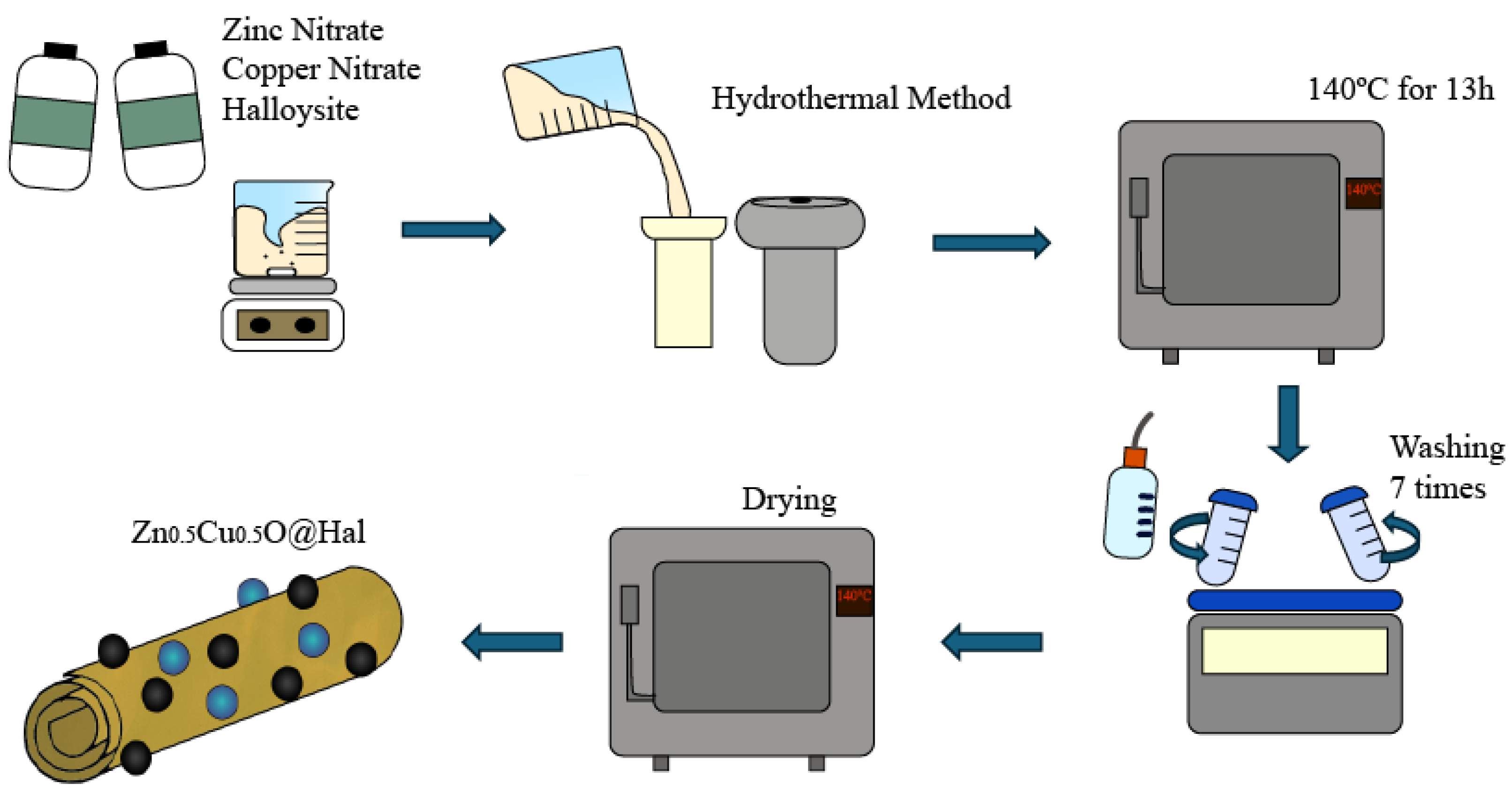

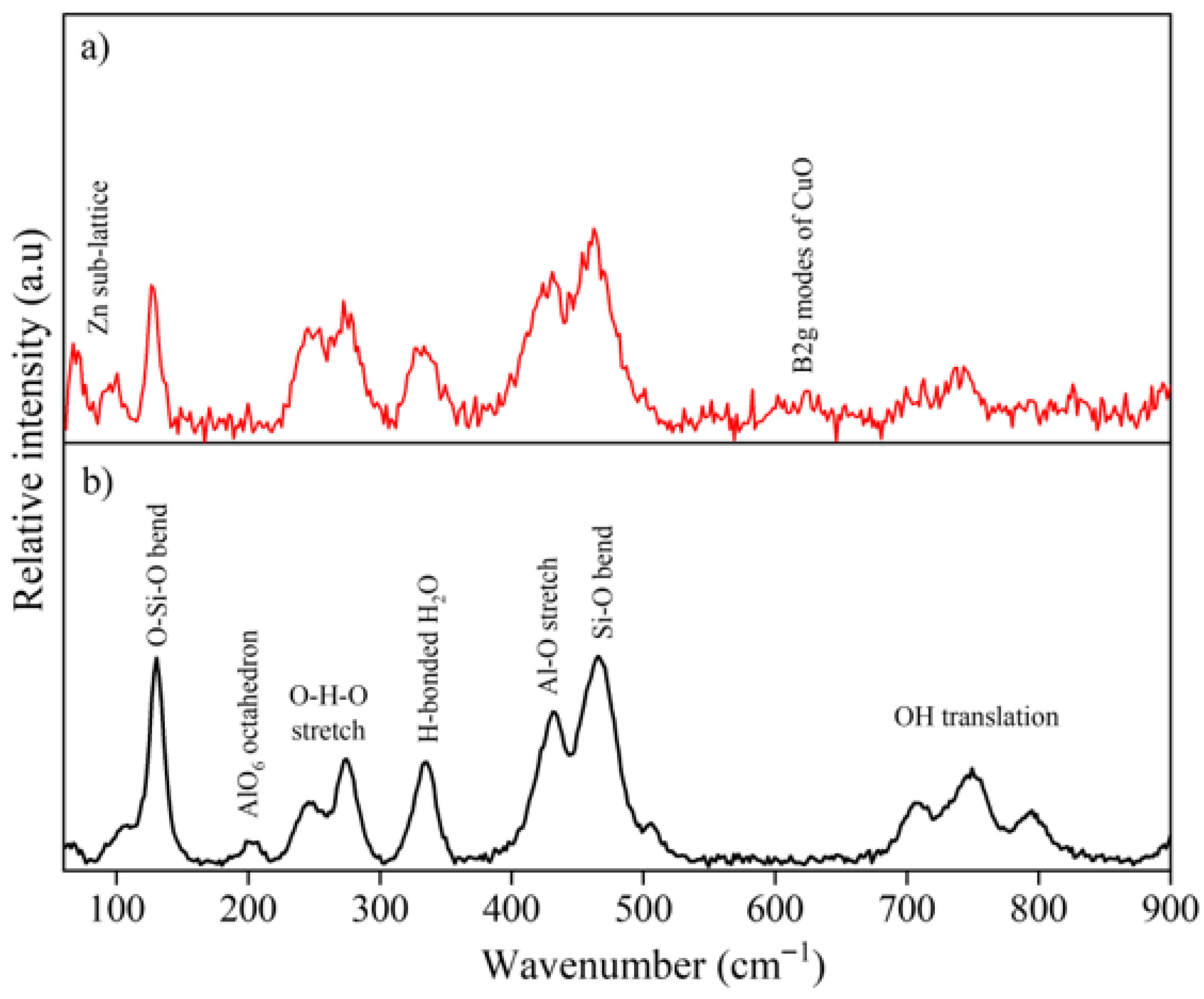
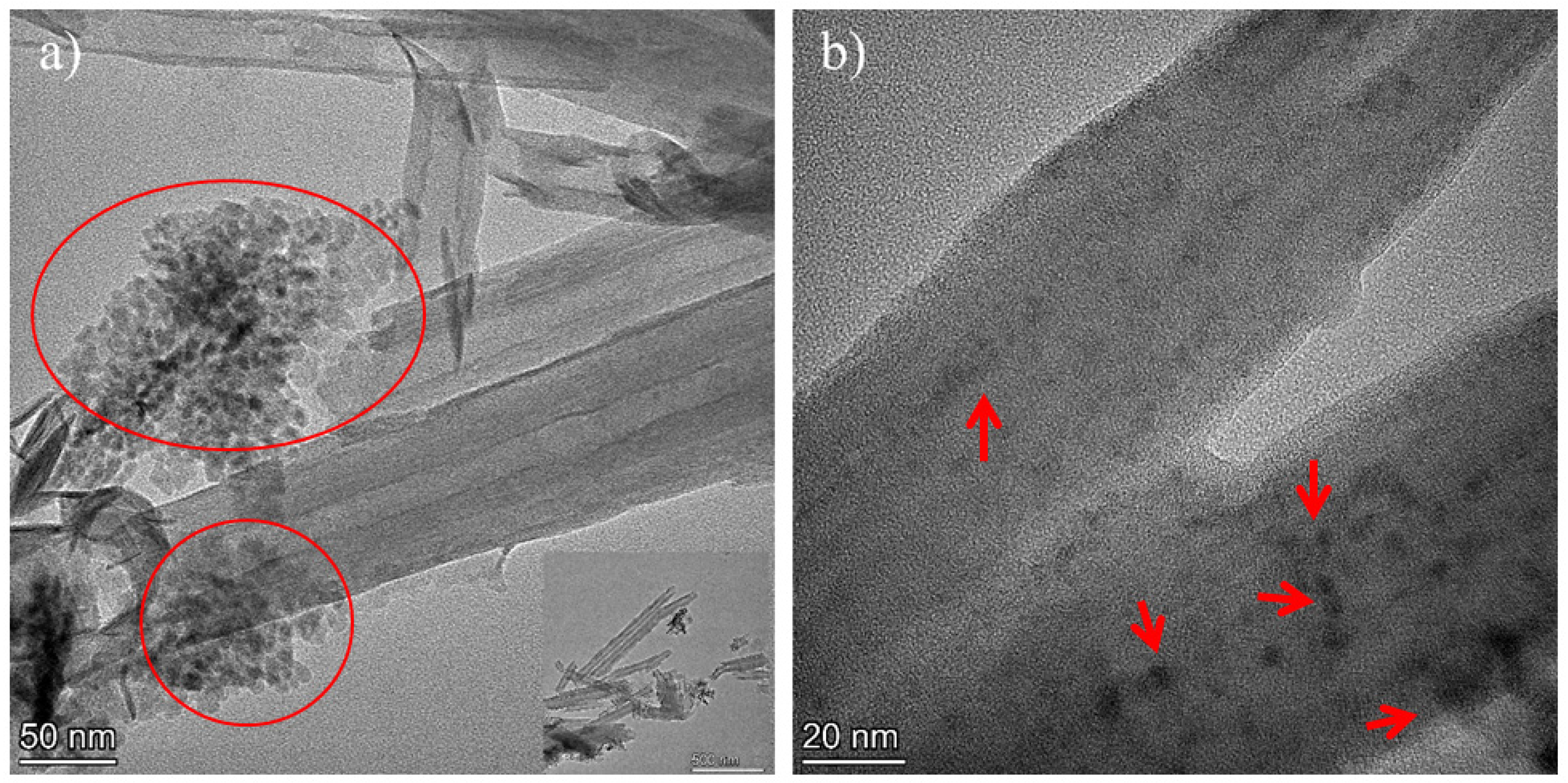
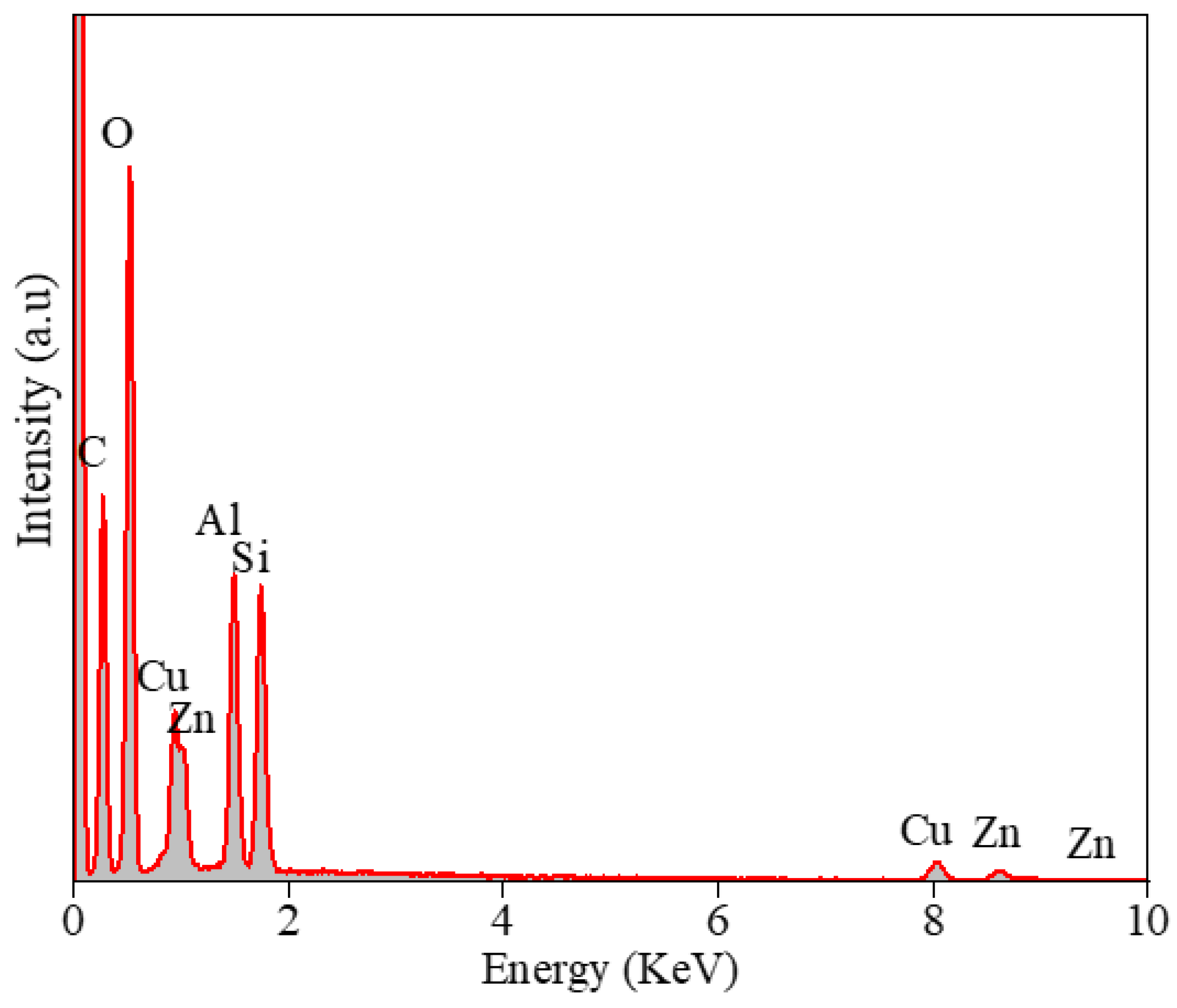
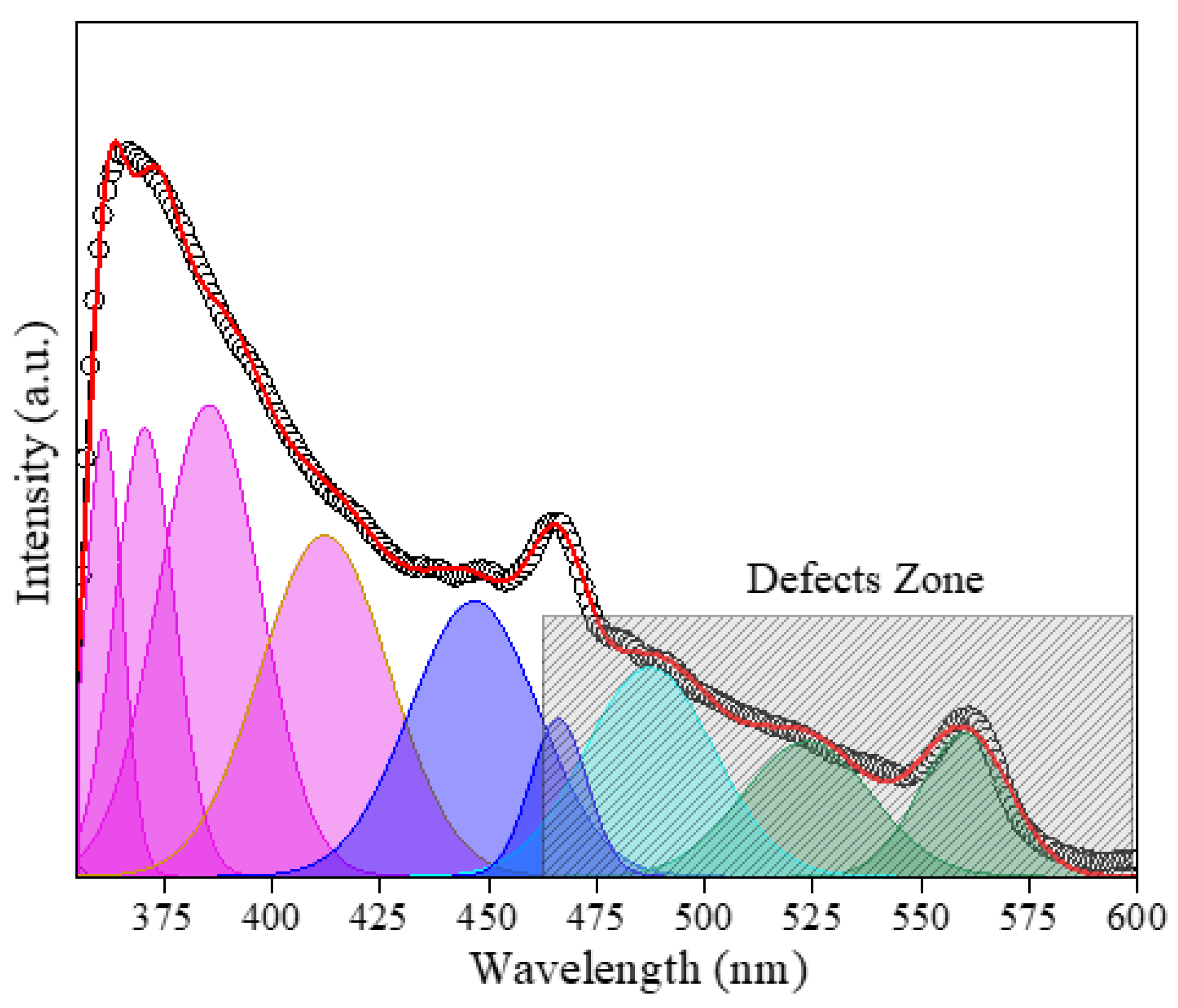
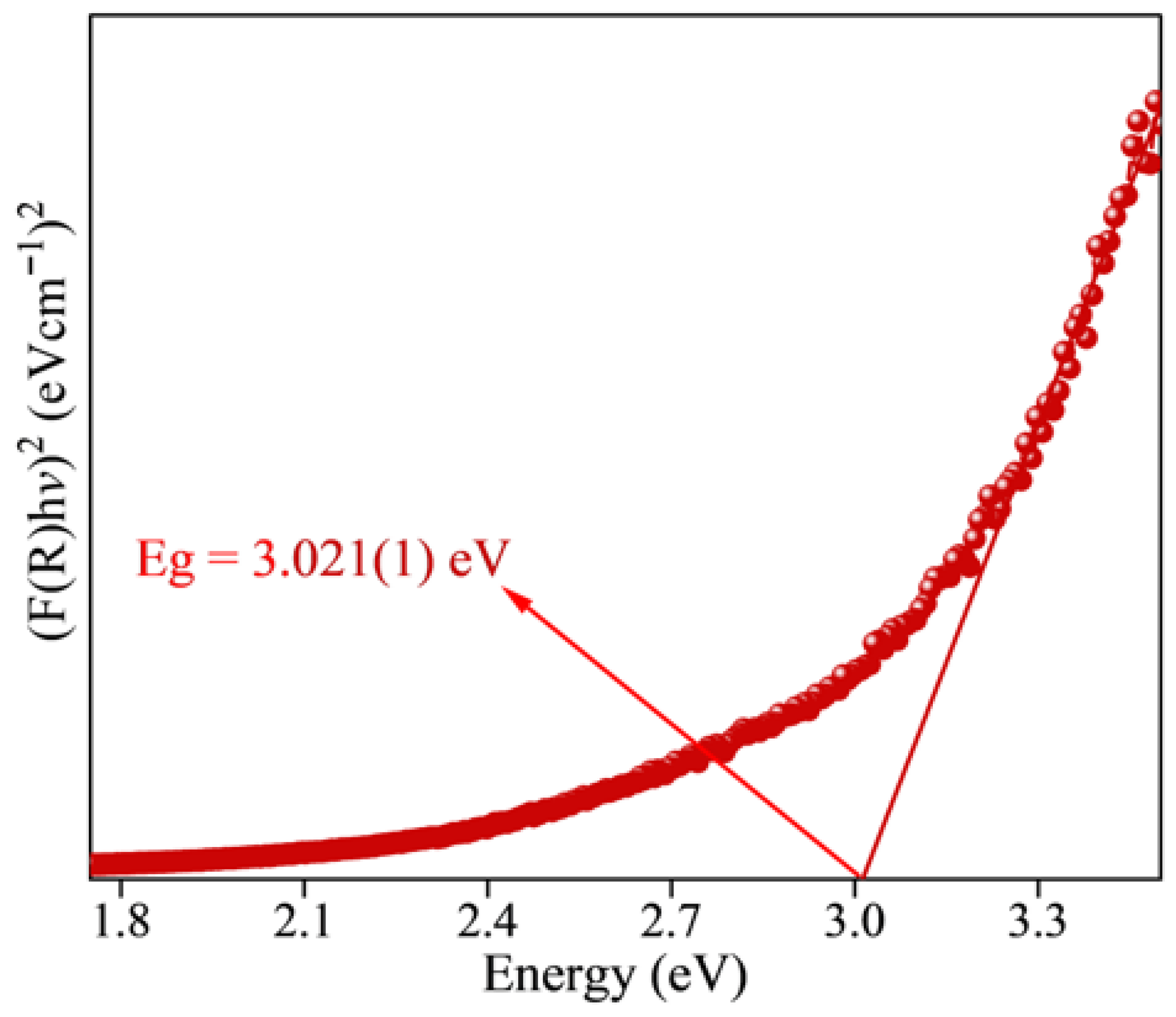
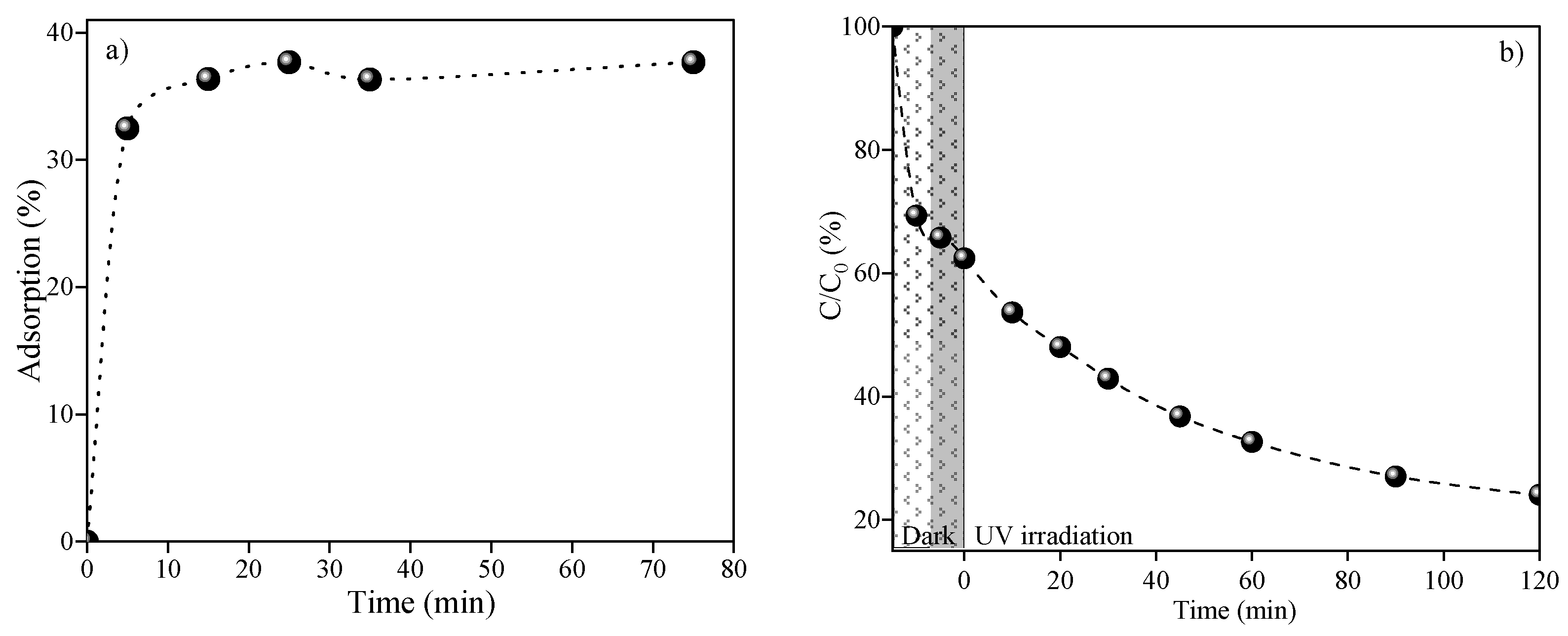
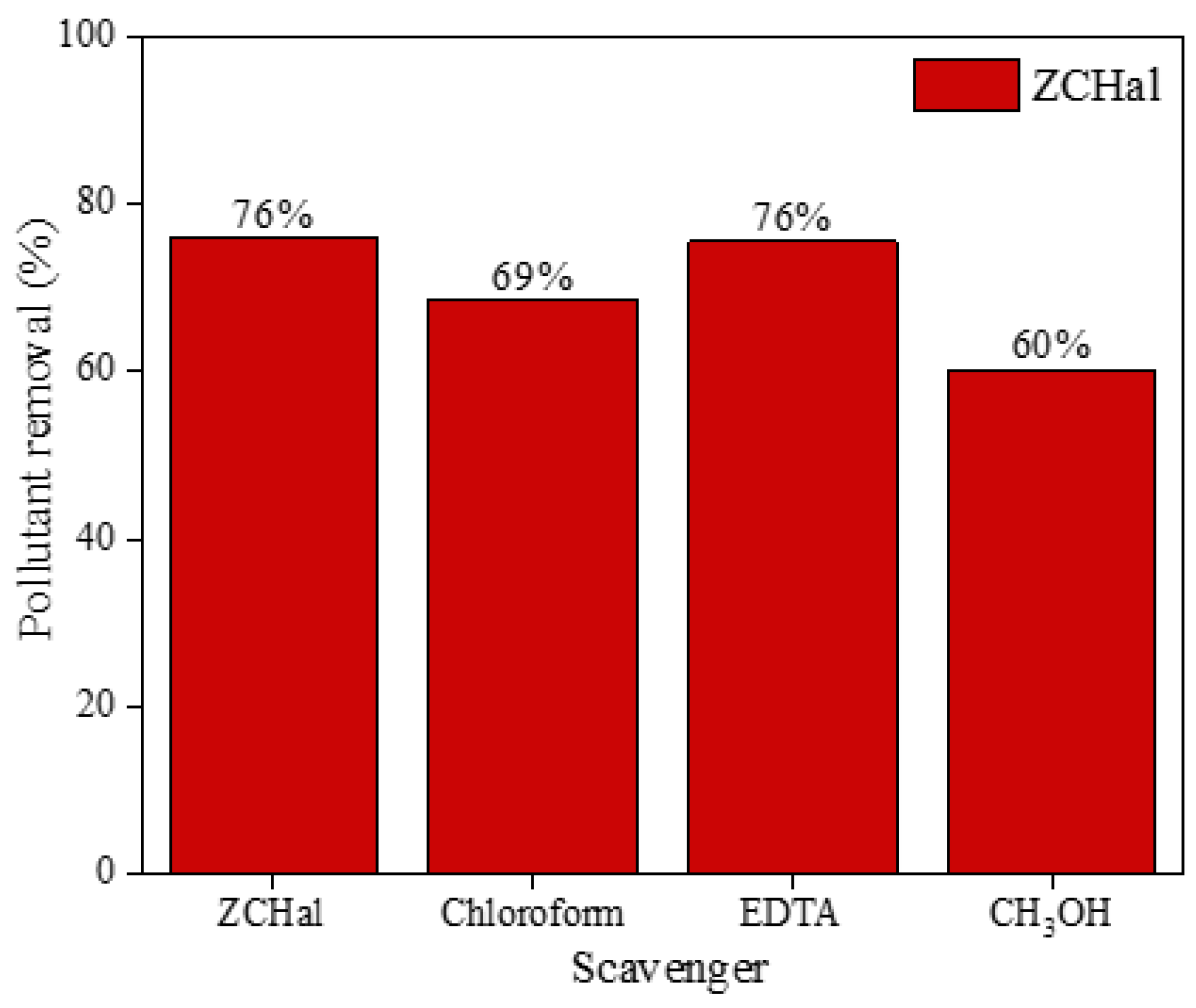
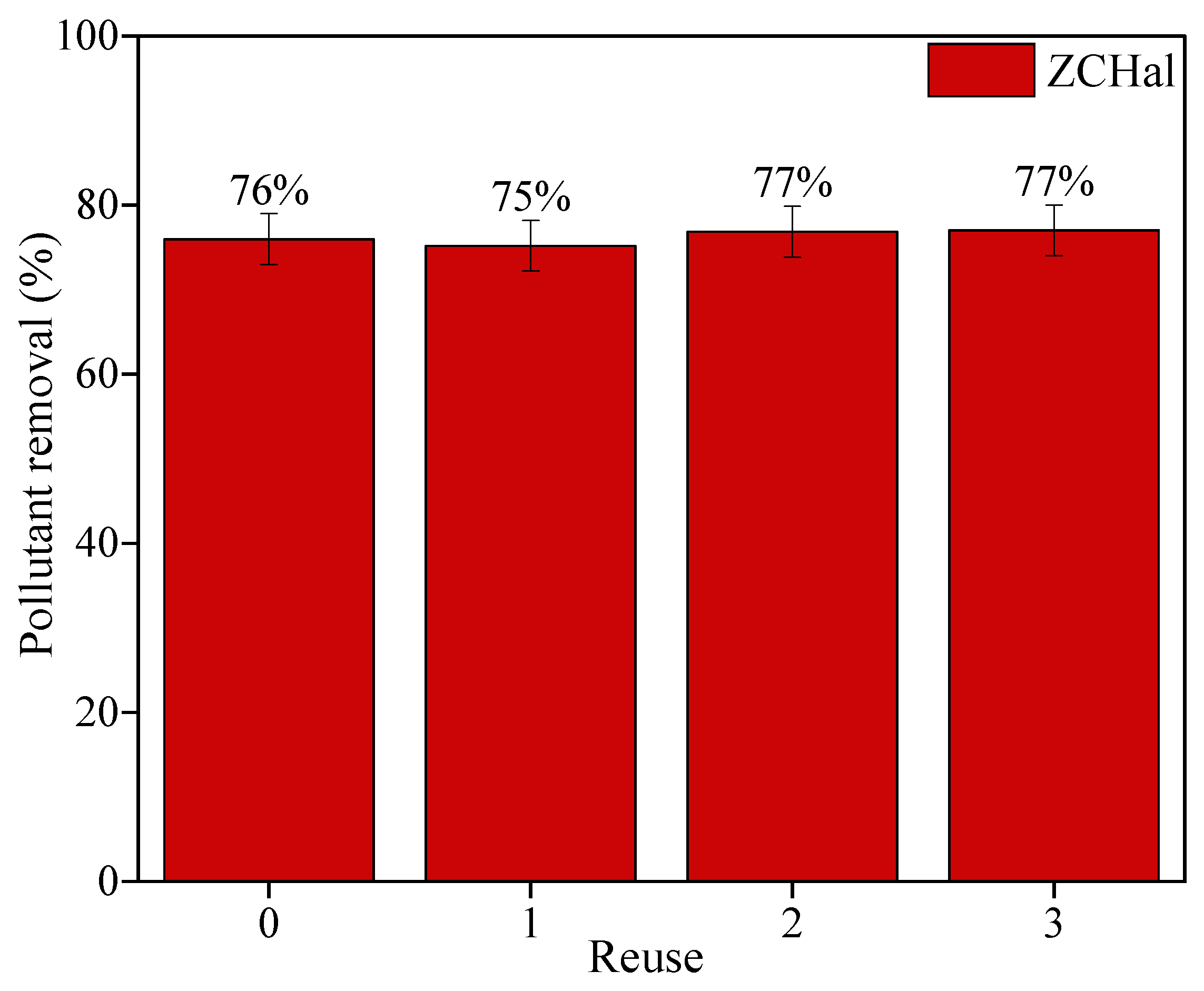
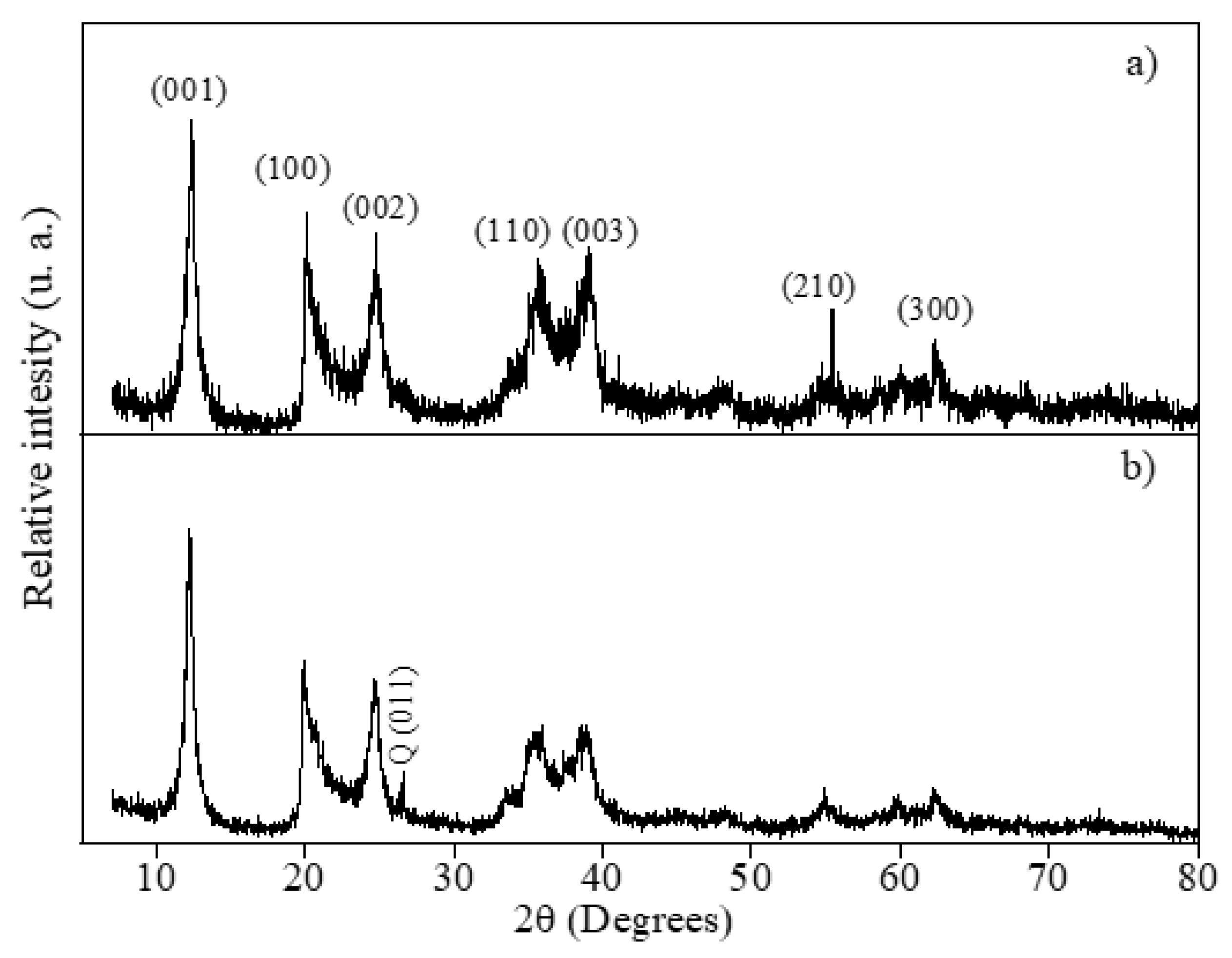
| Halloysite Band (cm−1) | ZCHal Band (cm−1) | Reported | Assignments | Reference |
|---|---|---|---|---|
| 97 | 99 | E2low of Zn sub-lattice | [38,39] | |
| 130 | 128 | 143 | O-Si-O bend of the Si205 unit | [32] |
| 202 | 200/205 | A1g (υ1) of AlO6 | [33,34] | |
| 246 | 248 | 238/245 | B2 (υ3) of O-H-O | [31,32,34] |
| 274 | 274 | 298/275 | A1 (υ1) of O-H-O | [31,32,34] |
| 335 | 332 | 336/334 | υ2 (e) of SiO4 | [33,34,40] |
| 432 | 428 | 432/428 | υ4 (f2) of SiO4 | [31,33,34] |
| 466 | 462 | 462/469 | υ4 (f2) of SiO4 | [31,33] |
| 505 | 501 | 512 | υ4 (f2) of SiO4 | [31] |
| 582 | 574/577 | A1 (LO) of ZnO | [38,41] | |
| 623 | 613/629 | B2g modes of CuO | [38,42] | |
| 707 | 712 | 710 | Si-O-Al translation | [31,33] |
| 748 | 740 | 747 | Si-O-Al translation | [33,40] |
| 796 | 794 | 787/793 | OH translation | [33,40] |
| 827 | 826 | Si-O-Al deformation | [31] |
| Sample | Synthesis Method | Photocatalyst Dosage (g L−1) | CIP Concentration (mg L−1) | Light Source | Time (min) | Removal (%) | References |
|---|---|---|---|---|---|---|---|
| TiO2/MMT | Hydrothermal | 0.2 | 10 | Sonoluminescence 600 W L−1 | 65.01 | [76] | |
| ZnO/PAL/HAL | Ultrasonic | 0.5 | 10 | Visible light | 120 | 82 | [69] |
| ZnO/BENT | Combustion | 1.0 | 100 | Sunlight | 180 | 97 | [77] |
| Ag-TiO2/rGO/HAL | 0.2 | 20 | UV | 300 | 90 | [75] | |
| g-C3N4/REC | Thermal polycondensation and calcination | 0.5 | 20 | Visible light | 360 | 70 | [78] |
| ZnO/CuO/HAL | Hydrothermal | 0.5 | 20 | UV | 120 | 76 | This work |
Disclaimer/Publisher’s Note: The statements, opinions and data contained in all publications are solely those of the individual author(s) and contributor(s) and not of MDPI and/or the editor(s). MDPI and/or the editor(s) disclaim responsibility for any injury to people or property resulting from any ideas, methods, instructions or products referred to in the content. |
© 2025 by the authors. Licensee MDPI, Basel, Switzerland. This article is an open access article distributed under the terms and conditions of the Creative Commons Attribution (CC BY) license (https://creativecommons.org/licenses/by/4.0/).
Share and Cite
Albuquerque, W.A.; Filho, A.J.N.; Romaguera-Barcelay, Y.; Medina-Carrasco, S.; Orta, M.d.M.; Trigueiro, P.; Peña-Garcia, R.R. Synergistic ZnO–CuO/Halloysite Nanocomposite for Photocatalytic Degradation of Ciprofloxacin with High Stability and Reusability. Minerals 2025, 15, 977. https://doi.org/10.3390/min15090977
Albuquerque WA, Filho AJN, Romaguera-Barcelay Y, Medina-Carrasco S, Orta MdM, Trigueiro P, Peña-Garcia RR. Synergistic ZnO–CuO/Halloysite Nanocomposite for Photocatalytic Degradation of Ciprofloxacin with High Stability and Reusability. Minerals. 2025; 15(9):977. https://doi.org/10.3390/min15090977
Chicago/Turabian StyleAlbuquerque, Willams A., Adilson J. Neres Filho, Yonny Romaguera-Barcelay, Santiago Medina-Carrasco, Maria del Mar Orta, Pollyana Trigueiro, and Ramón Raudel Peña-Garcia. 2025. "Synergistic ZnO–CuO/Halloysite Nanocomposite for Photocatalytic Degradation of Ciprofloxacin with High Stability and Reusability" Minerals 15, no. 9: 977. https://doi.org/10.3390/min15090977
APA StyleAlbuquerque, W. A., Filho, A. J. N., Romaguera-Barcelay, Y., Medina-Carrasco, S., Orta, M. d. M., Trigueiro, P., & Peña-Garcia, R. R. (2025). Synergistic ZnO–CuO/Halloysite Nanocomposite for Photocatalytic Degradation of Ciprofloxacin with High Stability and Reusability. Minerals, 15(9), 977. https://doi.org/10.3390/min15090977










